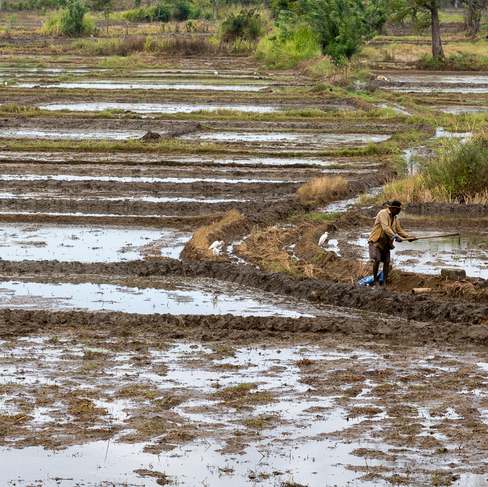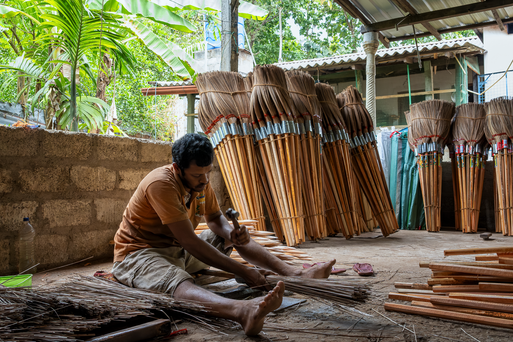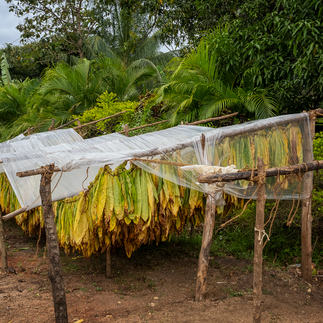Sigiriya and Habarana, Sri Lanka: March 27, 2024
- Cecilia Clark

- Mar 28, 2024
- 4 min read
Updated: Apr 4
After breakfast our guide and driver took us to the village of Moragaswava for a bike ride through the village. The length was about 12k and we were very glad that traffic wouldn't be an issue on this ride. The company that arranged the route, the stops, and supplied the bikes is called Hues of Habarana. The bike route was along a lakeside trail, over small off the beaten trail paths, and some paved walking paths past village homes. The bikes were in excellent shape with working brakes and comfortable seats. They had thicker tires to handle the off-road conditions. We had a bike guide and following behind at some distance a Tuk-Tuk for Plan B. Plan B was in case we got tired of riding, a vehicle was available to give us a lift. The Tuk-Tuk driver also stopped traffic for us at a two-lane road with a stop sign like a school crossing guard. So, it was the three of us and a trailing Tuk-Tuk on this tour. We stopped periodically to take photos, to visit some of the village's cottage industries, and to nosh.
To begin, we bicycled a trail with Habarana Lake on one side and rice paddy on the other side. Our first stop was at a woodcarving studio. After a brief look we were invited into a small shop to have tea and a snack of potato filled samosas and Dhal Vade balls. Both were delicious.
A dance school was our next stop where two of the teachers introduced the classic dances from Kandy and other regions in Sri Lanka. While one danced the other played the drums. Orchids were blooming in the dance school's garden.
We stopped at a one-man broom making factory. Coconut palm fronds are dried and separated into fibers (coir) that are then bundled and used for broom bristles. Two types of brooms are made: one is for interiors and the other (similar to a rake) for outside sweeping. The brooms are transported to local hardware shops where they sell for about $2 each. With constant use, a broom lasts about 2 months. The broomsticks are Sri Lankan mahogany.
Our ride continued to the home of a fisherwoman named Chaminie who served us freshly caught and fried Tilapia and a cup of herbal tea. The tea cup was 1/2 a coconut shell. The tilapia was crisp on the outside and tender on the inside. It was delicious.
From Chaminie's home we rode through a forested area with an electric fence on one side of the trail. The fence is to dissuade elephants and keep them away from the gardens. We rode past a brick making industry where all terracotta bricks are molded and shaped by hand. Next we arrived at the home of a maker of Ayurvedic oils. She and her helper showed us the process in turning Mee tree (Madhuca longifolia) nuts into oil. The Mee nuts are pounded to break the shell, the result is winnowed, the pulp is heated, the heated pulp is placed in a palm fiber bag that is then pressed until the oil has been completely extracted. The remaining pulp is used as compost. The oil has medicinal properties as an anti-inflammatory, antioxidant, analgesic, and for dermatological uses. She generously gave us a small bottle of Mee oil with instructions that it should be warmed and rubbed into sore joints.
We finished our ride where we began. The homeowner, Dilini, cooked a traditional rice and curry lunch. The creator behind the Hues of Habarana tour cooked huge forest prawns. We were joined by Indika and Thushara, our bike guide, the backup transport Tuk-Tuk driver, and we all sat down to a huge lunch.
It was a nice morning of Sri Lankan culture where we didn't have to remember any history. I enjoyed trying new foods and learning about how other people live, how they create art, and how they make a living from the surrounding environment.
On our way back to our lodging in Sigiriya we stopped a couple of times to take photos of things we found interesting. Along the road there are many small community gardens. The gardens have electric fences to keep elephants and other large animals from plundering the crops. There are lookout towers above the crops where villagers take turns keeping watch over the crops by night. We also saw tobacco leaves drying roadside.
While in Sigiriya we twice stayed at the Jetwing Vil Uyana in a Forest Dwelling which I think just means our room (actually a two-level, stand alone structure) isn't on the water. The upper story is the bedroom and a 1/2 bath while the downstairs full bath is partially open to the outdoors mimicking Geoffrey Bawa's Outside/Inside architectural technique. The first nights, I noticed bats coming into the bathroom while I was getting ready for bed. The lights were on and the bats worked their way into the palm fibers at the top of a post under the palm frond covered roof. They didn't bother me and I didn't bother them. On our second stay we were in a different Forest Dwelling 2-level room. We checked in late, went to dinner, and upon our return 1-1/2 hours later, there were two piles of excrement in different areas of the downstairs open bathroom. Housekeeping came to clean up the mess identifying bats as the culprits. He said we invited the bats in by turning off the downstairs lights. In our defense, when the card key is removed from the room, the lights go out. I think the Outside/Inside design approach probably worked better in Colombo.
Tomorrow, we move on to Dambulla


























































Comments